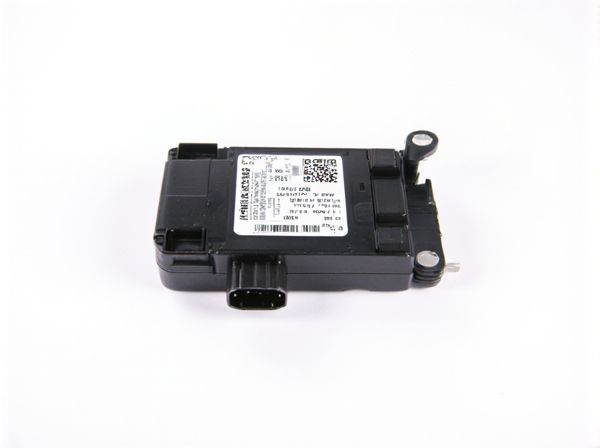
Photo illustration: Driver Airbag Module vs Passenger Airbag Module
Driver Airbag Modules are designed to deploy from the steering wheel, providing immediate protection to the driver by cushioning impact during a collision. Passenger Airbag Modules are installed in the dashboard or glove compartment, offering safety to front-seat passengers with deployment optimized for their seating position. Your vehicle's overall safety depends on both modules functioning properly to reduce injury risks for all occupants.
Table of Comparison
| Feature | Driver Airbag Module | Passenger Airbag Module |
|---|---|---|
| Location | Steering wheel center | Dashboard front passenger side |
| Size | Smaller, compact design | Larger to cover wider area |
| Deployment Speed | Extremely fast (within 20-30 ms) | Fast (within 30-40 ms) |
| Inflation Gas | Argon or nitrogen-based | Argon or nitrogen-based |
| Sensor Type | Driver impact and seat position sensors | Passenger presence and weight sensors |
| Purpose | Protect driver's head and chest during frontal collision | Protect passenger's head and chest during frontal collision |
| Additional Features | May include steering wheel controls and horn integration | May include multi-stage deployment based on passenger size |
Introduction to Airbag Modules
Driver airbag modules and passenger airbag modules are critical components of a vehicle's supplemental restraint system (SRS), designed to protect occupants during a collision. The driver airbag module is integrated within the steering wheel and deploys to shield the driver, while the passenger airbag module is typically housed in the dashboard to protect the front-seat passenger. Both modules consist of an inflator, cushion, and housing, programmed to deploy based on impact sensors and crash severity.
What is a Driver Airbag Module?
A Driver Airbag Module is a safety component integrated into the steering wheel, designed to rapidly deploy an airbag to protect the driver during a collision. It contains the airbag cushion, inflator, and control electronics that trigger inflation upon impact detection. This module differs from the Passenger Airbag Module, which is located in the dashboard and tailored to protect front-seat passengers with specific deployment parameters.
What is a Passenger Airbag Module?
A passenger airbag module is a safety component installed in the dashboard on the front passenger side, designed to rapidly deploy an inflatable cushion during a collision to protect the passenger from impact injuries. It consists of an inflator, airbag cushion, and housing, calibrated specifically for passenger-side deployment parameters. Unlike the driver airbag module located in the steering wheel, the passenger airbag module deploys with different force and timing to accommodate passenger size and seating position.
Key Differences Between Driver and Passenger Airbags
Driver airbag modules are typically smaller and designed to fit within the steering wheel, deploying directly towards the driver to provide maximum protection in frontal collisions. Passenger airbag modules are larger, housed in the dashboard, and deploy with more force and volume to accommodate a wider range of passenger sizes and seating positions. Key differences include deployment speed, size, and sensor calibration, with driver airbags tailored for closer proximity impact and passenger airbags optimized for broader protection scenarios.
Design and Placement in Vehicles
Driver airbag modules are typically housed in the center of the steering wheel, designed to deploy directly towards the driver for maximum protection during frontal collisions. Passenger airbag modules are installed within the dashboard above the glove compartment, engineered to deploy towards the front-seat passenger while minimizing injury risk through controlled inflation patterns. Both modules incorporate advanced sensors and adaptive designs tailored to their specific placement and occupant position for optimal safety performance.
Activation Mechanisms Compared
Driver airbag modules typically activate using dual-stage inflators triggered by signals from the impact sensors located on the steering column, allowing for rapid deployment tailored to crash severity and driver positioning. Passenger airbag modules often employ multi-stage inflators with pressure sensors embedded in the dashboard to adjust inflation rates based on occupant weight and seating position, enhancing safety while minimizing injury risks. Both systems rely on accelerometers and crash data processors, but passenger modules integrate additional occupant detection technologies to optimize deployment timing and force.
Safety Features and Efficacy
Driver airbag modules are engineered with advanced sensors and rapid deployment mechanisms to reduce crash impact forces on the driver's chest and head, enhancing frontal collision safety. Passenger airbag modules incorporate adaptive inflation technology and occupant weight detection systems to optimize cushioning, minimizing injury risk for various passenger sizes and seating positions. Both modules integrate with the vehicle's safety systems to provide synchronized deployment, significantly improving overall occupant protection in diverse crash scenarios.
Maintenance and Replacement Costs
Driver airbag modules typically incur lower maintenance and replacement costs compared to passenger airbag modules due to their simpler deployment mechanisms and smaller size. Passenger airbag modules often require more comprehensive repairs because they include additional sensors and inflators, increasing both parts and labor expenses. Insurance premiums and manufacturer recalls also tend to impact passenger airbag module costs more significantly, affecting overall maintenance budgets.
Common Issues and Troubleshooting
Driver airbag modules often face issues with sensor malfunctions, wiring faults, and module communication errors that trigger warning lights and disable deployment. Passenger airbag modules commonly encounter problems related to seat occupancy sensors, connector corrosion, and software glitches affecting activation reliability. Troubleshooting both involves diagnosing error codes with a scan tool, inspecting electrical connections, and performing reset procedures or module replacements to ensure proper airbag system functionality.
Choosing the Right Airbag Module for Your Vehicle
Selecting the right airbag module, whether a driver airbag module or a passenger airbag module, is crucial for optimizing vehicle safety and compatibility. Driver airbag modules are specifically designed to integrate with the steering wheel assembly, tailored to the driver's position, while passenger airbag modules fit within the dashboard area to protect front-seat passengers effectively. Ensuring the module matches your vehicle's make, model, and year guarantees proper deployment, enhances crash protection, and maintains compliance with safety regulations.
 caratoz.com
caratoz.com